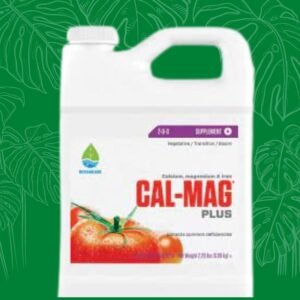Last Updated 3 years by Shariful Alam Pavel
Plants need supplements for the very reasons that we animals need them. They need to develop, ward off infections, and reproduce. A lack of certain nutrients can have a vast effect on plant growth thus in turn affecting the quality. Hemp plant for CBD needs this supplement like other plants.
This article helps you understand what is CalMag plus and how it affects cultivation. It also dives deep into the benefits of the nutrients that the product contains and the deficiency due to lack of it.
Table of Contents
What is Cal-Mag Plus?
Cal-Mag Plus is a plant-based supplement that is neutral in PH. This is fundamental for the best retention of calcium. Cal-Mag Plus tends to address the lack of certain macronutrients in plants such as
- Calcium
- Magnesium
- Iron

Cal-Mag Plus
This is very important for commercial cultivation of CBD even for indoor hemp farming as well!
What are macronutrients?
Macronutrients are fundamental for plant development and well-being.
There are 2 types of macronutrients:
Primary Macronutrients● Nitrogen (N) ● Phosphorus (P) ● Potassium (K). |
Secondary Macronutrients● Calcium (Ca) ● Magnesium (Mg) ● Sulfur (S). |
Plants consume primary nutrients more in contrast to secondary nutrients. Each of these nutrients has a particular function crucial for the growth of plants. A lack of any of the nutrients can prompt various deficiencies. This may affect the plants relying on which supplement is missing and in what quantity.

uprightCBD
How does the following nutrient that is present in Cal-Mag Plus constitute growth?
CalciumWhat Function does Calcium play in plants?● Calcium is present in the form of calcium pectate in plants. This is what keeps the cell wall together. Solid cell walls control the exchange of nutrients to the different parts of the plant. ● It additionally invigorates photosynthesis which makes the use of nitrogen much more effective. ● It is likewise significant in actuating specific compounds. It conveys signals that coordinate specific cell activities. ● Calcium is critical in the growth of root growth advancement. Calcium likewise increases the protection from outside ambush.
How does Calcium deficiency affect plants?Plant roots take calcium by means of transpiration. It is the movement of water to different parts of the plants. Transpiration is essential for the healthy growth of plants. It disposes of an overabundance of water. It also keeps up an appropriate equilibrium between salts and water. Different circumstances can slow down transpiration, like cold temperatures or increased humidity. Which thus ignites Calcium deficiency
|
How do detect whether a plant is suffering from Calcium deficiency?
Distinguishing an absence of calcium in your plants is easy to identify. Watch out for these few side effects:
● When plants lack calcium. The development of leaves begins to twist. This is often alluded to as “parachute leaves.” When this happens on new leaves. It might be due to deficient calcium within plants’ framework.
● Earthy-colored spots can consume the edges of the leaf. Yellow chlorosis can influence the whole leaves. If you don’t look into it, this might spread and progress towards the demise of leaves. There may be countless explanations behind this sort of symptom. So you must conduct a dirt test to figure out what your plant lack.
● The decay of all kinds, of new leaves, fruit, or blossom can be due to a lack of calcium. Assuming that you noticed the decay over the ground, it’s logical there it has made its way towards the root. Act as soon as possible to forestall unexpected demise.
IronWhat Function does Iron play in plants?● It helps in the transportation of oxygen to different parts of the plant such as roots and leaves. ● Albeit iron doesn’t help in the synthesis of chlorophyll. It is crucial for its development. Chlorophyll is a green pigment present in all green plants. This green pigment absorbs light to provide energy for photosynthesis. ● Iron is an important component of various enzyme reactions in plants. Iron also aids in the reduction of nitrate and sulfate
|
What may cause Iron deficiency?
There may be several reasons why a plant may be suffering from iron deficiency. Here are a few of them:
● Each nutrient that a plant needs, including iron, there is an ideal pH range. Within this range, the nutrients are accessible. This makes it simple for plants to ingest nutrients through the roots. On the off chance that the dirt has an impartial or basic pH, above 6.5 to 7.0, iron is less accessible to plants. A soil alkaline may likewise have a high calcium level, which slows down iron intake.
● Aside from having enough of every supplement in the dirt. It is crucial to ensure the legitimate proportions for every nutrient. A lot of one nutrient can hinder a plant from retaining another. Like having an excess of phosphorus in the dirt can hamper iron fixation. It is ideal to investigate the rate by weight of nutrients before beginning your venture.
● The sort of soil can likewise cause a lack of iron in plants. If your mud is too wet or a bit too stuffed, there won’t be enough air for iron take-up.
How does Iron deficiency affect plants?
A few of the side effects due to iron deficiency:
● The common side effect of lack of iron is leaf chlorosis. This is the point when the leaves of the plant become yellow, yet the veins of the leaves remain green.
● They have symptoms of stunt growth and poor flowering.
● They are also vulnerable to sunburn. This prompts the leaves to fall and the death of cells in the shoot region.

uprightCBD
Magnesium
Magnesium is an exceptional divalent ion portable in soil. Magnesium’s a notable element in the photosynthesis process. This is because it provides a structure block for the formation of chlorophyll. Lack of magnesium may be a critical hampering the quality of crop produced.
It makes its way into the root by diffusion as well as a massive stream. The amount of magnesium that ends up in plants depends on :
- Soil arrangement
- Soil temperature
- Soil dampness
- Soil pH
- The ability to trade the cation.
What causes a shortage of Magnesium in the soil?
Having a decent knowledge of the causes can help you resolve the issue sooner. Here are a few of the causes behind magnesium deficiency:
● Soils that have a low pH range are bound to cause a lack of magnesium in plants. Magnesium turns out to be less solvent, and the plant roots struggle with taking it up.
● The soil can turn out to be too heavy for plants to be able to absorb magnesium. This can occur because of overwatering or too much rainfall. This can oversaturate the soil. This heavy amount of water can leach magnesium along with other nutrients from the soil.
● While potassium is an essential part of plant development. Yet, having a lot of potassium in the dirt can prompt a lack of magnesium. This is due to the plenty of potassium contends with magnesium for racing its way into the plant roots. Plants are more able to ingest potassium due to it being more soluble. To forestall this, you can conduct a soil test.
● The common reason for lack of magnesium is inconsistent fertilization. Plants need an abundant stock of magnesium to keep up with their development. Ensure that you provide fertilization on a regular basis. This is critical, particularly during the developing season.
How do detect whether a plant doesn’t have enough magnesium in its system?
Edges of the leaf turn brownish or purple in color. Besides, it also makes the leaves yellow while their veins stay green. This may likewise be because of an absence of iron, it is ideal to carry out a soil test to have a grasp on the actual cause.

Cal-Mag Plus
Some Common questions revolving around Cal-Mag
Can Cal-Mag Plus be applied to the soil?
You ought to use Cal-Mag assuming there is an absence of nutrients that comprises the product. Calcium and magnesium are vital nutrients that enhance plant growth. This is other than the principal supplements nitrogen, phosphorus, and potassium. Cal-Mag doesn’t influence the primary macronutrients like Nitrogen, phosphorus, and potassium. It only helps the micronutrients present in the soil for plants to enjoy the benefit.
How do I use Cal-Mag Plus along with a dirt-based plant?
Cal-Mag is very simple to use alongside soil-based plants. Blend in one spoon of Cal-Mag to every gallon of water. You can apply it the same way you water plants. You can likewise use Cal-Mag to speed up growth. You can do this, by adding an extra spoon to every gallon of water.
Can Cal-Mag Plus Be Used for a Foliar Spray?
Cal-Mag Plus functions well when sprayed. You can blend it in with water and spray it all over the plant. In any case, try not to apply with a similar type of supplement. This may prompt unfortunate outcomes.
Can Cal-Mag Plus be used whilst hydroponic cultivation?
Hydroponic cultivation depends on fluid for growth. Cal-Mag can have an immense effect on plants’ well-being. This is because it provides plants with solid degrees of optional nutrients. You can add Cal-Mag to the container each time you change the water. You can likewise add it each time you top off water levels. This only involves adhering to the guidelines on the Cal-Mag. Adding Cal-Mag to your framework comprises blending a deliberate sum then shaking and emptying it into your container.
Does Cal-Mag Plus affect PH?
Cal-Mag might influence pH levels for sure. Try to peruse the label of your item on its impact on pH levels. While involving Cal-Mag for hydroponics, it’s prescribed to change pH levels before use. Having an exact watch to follow PH can keep away the mystery and help to maintain an appropriate level.
Final words on Cal-Mag Plus
Cal-Mag is a unique product for plants that lack certain nutrients or need a little boost. If you’re in need of a decent product to give your plants better blossoms, bigger fruits, or a cure from root decay. Cal-Mag can be an extraordinary solution worth giving a try. You Can Buy this from Amzon.


Recent Comments